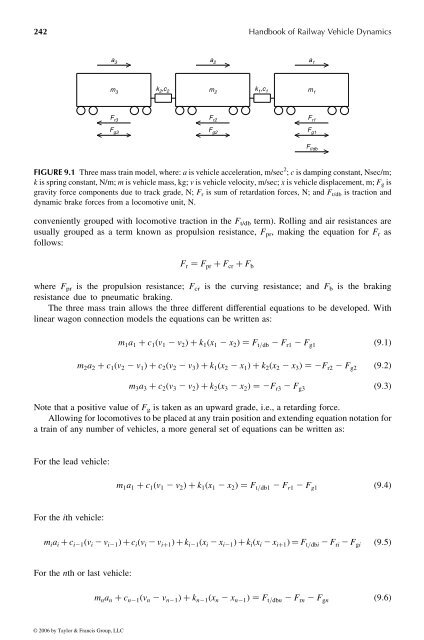Hi-Res PDF - CRCnetBASE
Hi-Res PDF - CRCnetBASE
Hi-Res PDF - CRCnetBASE
You also want an ePaper? Increase the reach of your titles
YUMPU automatically turns print PDFs into web optimized ePapers that Google loves.
242<br />
conveniently grouped with locomotive traction in the F t/db term). Rolling and air resistances are<br />
usually grouped asaterm known as propulsion resistance, F pr, making the equation for F r as<br />
follows:<br />
F r ¼ F pr þ F cr þ F b<br />
where F pr is the propulsion resistance; F cr is the curving resistance; and F b is the braking<br />
resistance due to pneumatic braking.<br />
The three mass train allows the three different differential equations to be developed. With<br />
linear wagon connection models the equations can be written as:<br />
m 1 a 1 þ c 1 ð v 1 2 v 2 Þþk 1 ð x 1 2 x 2 Þ¼F t = db 2 F r1 2 F g1<br />
m 2 a 2 þ c 1 ð v 2 2 v 1 Þþc 2 ð v 2 2 v 3 Þþk 1 ð x 2 2 x 1 Þþk 2 ð x 2 2 x 3 Þ¼2 F r2 2 F g2<br />
m 3 a 3 þ c 2 ð v 3 2 v 2 Þþk 2 ð x 3 2 x 2 Þ¼2 F r3 2 F g3<br />
Note that apositive value of F g is taken as an upward grade, i.e., aretarding force.<br />
Allowing for locomotives to be placed at any train position and extending equationnotation for<br />
atrain of any number of vehicles, amore general set of equations can be written as:<br />
For the lead vehicle:<br />
For the i th vehicle:<br />
a 3<br />
m 1 a 1 þ c 1 ð v 1 2 v 2 Þþk 1 ð x 1 2 x 2 Þ¼F t = db1 2 F r 1 2 F g 1<br />
m i a i þ c i 2 1 ð v i 2 v i 2 1 Þþc i ð v i 2 v i þ 1 Þþk i 2 1 ð x i 2 x i 2 1 Þþk i ð x i 2 x i þ 1 Þ¼F t = dbi 2 F r i 2 F g i<br />
For the n th or last vehicle:<br />
m k<br />
3 2 ,c2 m k<br />
2 1 ,c1 m 1<br />
F r3<br />
F g3<br />
a 2<br />
F r2<br />
F g2<br />
FIGURE 9.1 Three mass train model, where: a is vehicle acceleration, m/sec 2 ; c is damping constant, Nsec/m;<br />
k is spring constant, N/m; m is vehicle mass, kg; v is vehicle velocity, m/sec; x is vehicle displacement, m; F g is<br />
gravity force components due to track grade, N; F r is sum of retardation forces, N; and F t/db is traction and<br />
dynamic brake forces from alocomotive unit, N.<br />
© 2006 by Taylor & Francis Group, LLC<br />
Handbook of Railway Vehicle Dynamics<br />
m n a n þ c n 2 1 ð v n 2 v n 2 1 Þþk n 2 1 ð x n 2 x n 2 1 Þ¼F t = dbn 2 F r n 2 F g n<br />
a 1<br />
F r1<br />
F g1<br />
F t/db<br />
ð 9 : 1 Þ<br />
ð 9 : 2 Þ<br />
ð 9 : 3 Þ<br />
ð 9 : 4 Þ<br />
ð 9 : 5 Þ<br />
ð 9 : 6 Þ









